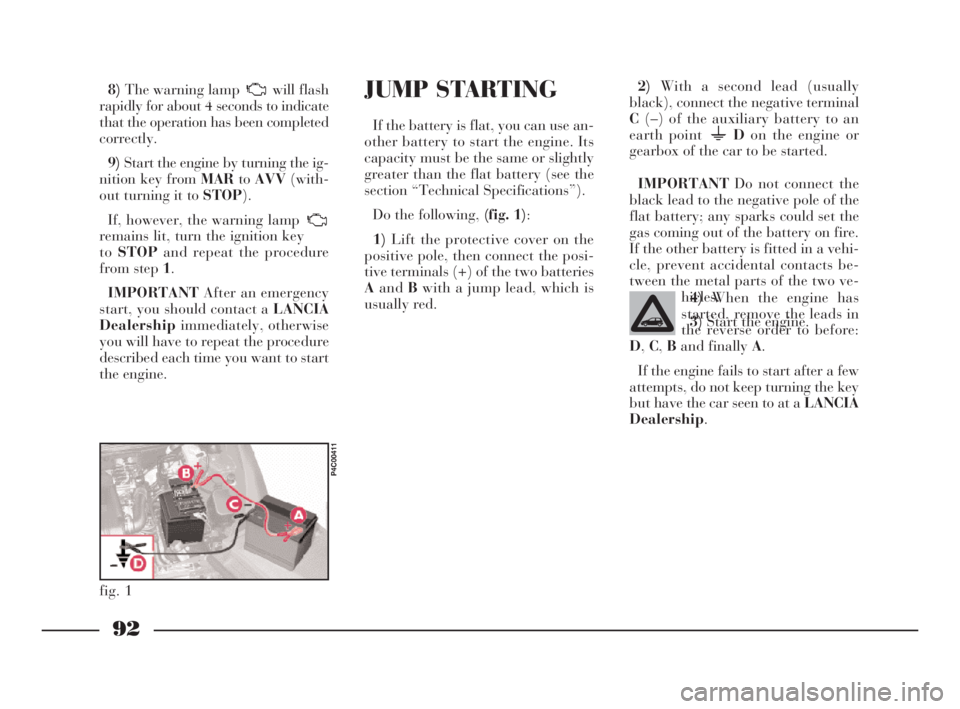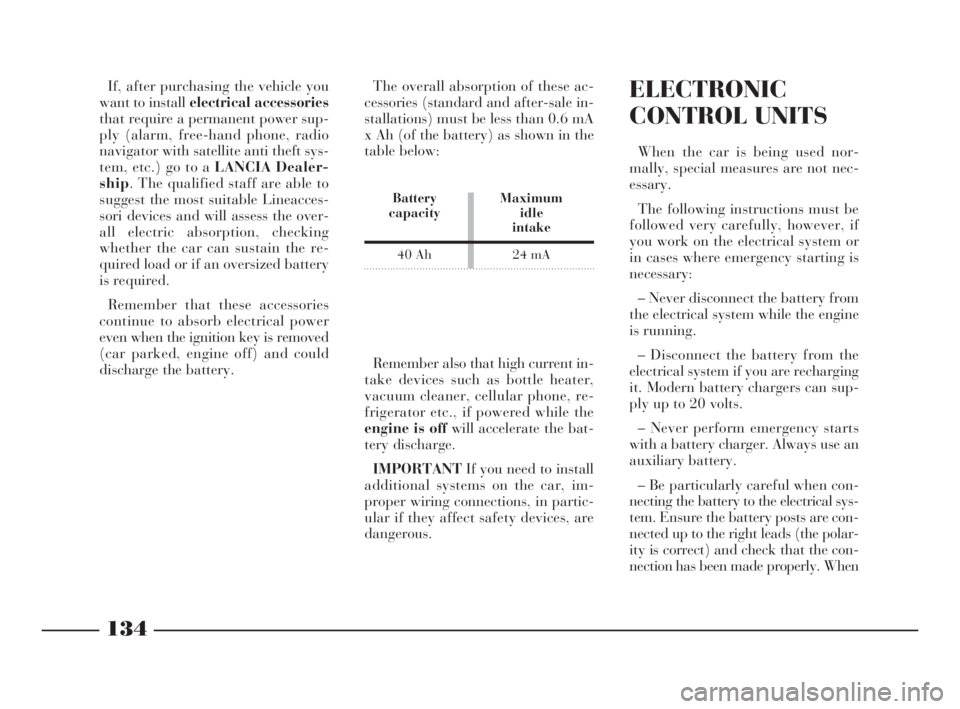battery capacity Lancia Ypsilon 2002 Owner handbook (in English)
[x] Cancel search | Manufacturer: LANCIA, Model Year: 2002, Model line: Ypsilon, Model: Lancia Ypsilon 2002Pages: 191, PDF Size: 2.45 MB
Page 90 of 191

87
G
The maximum speed of
snow tyres with a “Q” in-
dication must never ex-
ceed 160 km/h and in any case
must always observe the regula-
tions of the Highway Code.Therefore they should only be used
for the purpose for which they have
been homologated (“Q” indicates that
the tyre is designed for a speed of less
than 160 km/h).
IMPORTANTWhen using snow
tyres with a maximum speed index
that is less than the capacity of the car
(increased by 5%), place in the pas-
senger compartment, well in sight, a
warning that indicates the maximum
speed permitted by the snow tyres (in
accordance with the EC Directive).
Fit four identical tyres (same make
and tread) on the wheels to ensure
safety when driving and when brak-
ing as well as easy handling.
Do not reverse the direction of rota-
tion of the tyres.STORING THE CAR
Do the following if the car is not to
be used for more than a month:
– Park the car in covered, dry and if
possible well-ventilated premises.
– Engage a gear.
– Remove the cables from the bat-
tery terminals (first remove the cable
to the negative terminal) and check
the battery charge. This check should
be carried out once every three
months while the car is in storage.
Recharge the battery if the no-load
voltage is less than 12.5V.
– Make sure the handbrake is not
engaged.
– Clean and protect the painted
parts using protective wax.
4C068-089 ING 11-03-2008 11:59 Pagina 87
Page 95 of 191

92
G
8)The warning lamp will flash
rapidly for about 4 seconds to indicate
that the operation has been completed
correctly.
9)Start the engine by turning the ig-
nition key from MARtoAVV(with-
out turning it to STOP).
If, however, the warning lamp
remains lit, turn the ignition key
toSTOPand repeat the procedure
from step 1.
IMPORTANTAfter an emergency
start, you should contact a LANCIA
Dealershipimmediately, otherwise
you will have to repeat the procedure
described each time you want to start
the engine.JUMP STARTING
If the battery is flat, you can use an-
other battery to start the engine. Its
capacity must be the same or slightly
greater than the flat battery (see the
section “Technical Specifications”).
Do the following, (fig. 1):
1)Lift the protective cover on the
positive pole, then connect the posi-
tive terminals (+) of the two batteries
AandBwith a jump lead, which is
usually red.2)With a second lead (usually
black), connect the negative terminal
C(–) of the auxiliary battery to an
earth point Don the engine or
gearbox of the car to be started.
IMPORTANTDo not connect the
black lead to the negative pole of the
flat battery; any sparks could set the
gas coming out of the battery on fire.
If the other battery is fitted in a vehi-
cle, prevent accidental contacts be-
tween the metal parts of the two ve-
hicles.
3)Start the engine.
4)When the engine has
started, remove the leads in
the reverse order to before:
D,C,Band finally A.
If the engine fails to start after a few
attempts, do not keep turning the key
but have the car seen to at a LANCIA
Dealership.
fig. 1
P4C00411
4C090-119 ING 11-03-2008 12:00 Pagina 92
Page 137 of 191

134
G
If, after purchasing the vehicle you
want to install electrical accessories
that require a permanent power sup-
ply (alarm, free-hand phone, radio
navigator with satellite anti theft sys-
tem, etc.) go to a LANCIA Dealer-
ship. The qualified staff are able to
suggest the most suitable Lineacces-
sori devices and will assess the over-
all electric absorption, checking
whether the car can sustain the re-
quired load or if an oversized battery
is required.
Remember that these accessories
continue to absorb electrical power
even when the ignition key is removed
(car parked, engine off) and could
discharge the battery.The overall absorption of these ac-
cessories (standard and after-sale in-
stallations) must be less than 0.6 mA
x Ah (of the battery) as shown in the
table below:ELECTRONIC
CONTROL UNITS
When the car is being used nor-
mally, special measures are not nec-
essary.
The following instructions must be
followed very carefully, however, if
you work on the electrical system or
in cases where emergency starting is
necessary:
– Never disconnect the battery from
the electrical system while the engine
is running.
– Disconnect the battery from the
electrical system if you are recharging
it. Modern battery chargers can sup-
ply up to 20 volts.
– Never perform emergency starts
with a battery charger. Always use an
auxiliary battery.
– Be particularly careful when con-
necting the battery to the electrical sys-
tem. Ensure the battery posts are con-
nected up to the right leads (the polar-
ity is correct) and check that the con-
nection has been made properly. When Remember also that high current in-
take devices such as bottle heater,
vacuum cleaner, cellular phone, re-
frigerator etc., if powered while the
engine is off will accelerate the bat-
tery discharge.
IMPORTANTIf you need to install
additional systems on the car, im-
proper wiring connections, in partic-
ular if they affect safety devices, are
dangerous.
Battery Maximum
capacity idle
intake
40 Ah 24 mA
4C120-143 ING 11-03-2008 12:01 Pagina 134
Page 158 of 191

155
G
ELECTRICAL
SYSTEM
Power supply voltage: 12 Volts.
BATTERY
With negative earth.STARTER MOTOR
With pinion and free wheel. En-
gagement through electromagnet op-
erated by the ignition key.
Power output:
All versions ......................... 0.8 kW
ALTERNATOR
Rectifier bridge and built-in elec-
tronic voltage regulator. Battery be-
gins recharging as soon as the engine
starts.
Maximum rated current output:
1.2
1.216V....................................65A
All versions
with climate control ..................75A
WHEEL GEOMETRY
Front wheel toe-in measured from
rim to rim: 0±1 mm.
The figures refer to the car in full
running order.Modifications or repairs
to the electrical system
carried out incorrectly and
without bearing the features of the
system in mind can cause mal-
functions with the risk of fire.
Version Capacity 20 hr Cold crankingdischarge rate power (–18°C)
1.2 - 1.2 16V40Ah 200A
4C144-167 ING 11-03-2008 12:02 Pagina 155